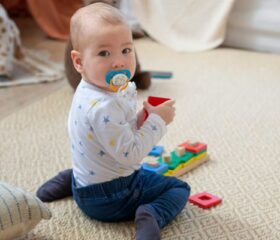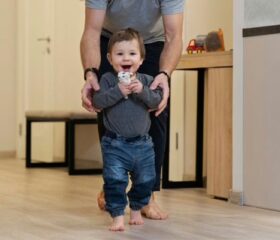Baby Month by Month
10-Month-Old Baby
Your baby may be able to pull herself up to stand now.

Get ready for a whirlwind of movement, communication, and a little more independence. Your baby is getting increasingly mobile and curious about her surroundings—better start baby-proofing your house!
Let’s look at how she’s developing and how to look after your 10-month-old baby.

Your baby’s developments at 10 months old
While your baby still needs a lot of attention, she’s getting increasingly independent and developing faster than you probably thought possible.
Physical development and coordination
Your ten-month-old is on a mission to explore, and her physical development reflects this. Here’s what you might observe this month:
- Crawling: Your baby might have already started crawling by this age, and she may be experimenting with different crawling styles.
- Pulling to stand: Furniture will become your baby’s best friend as she learns to pull herself into a standing position.
- Cruising: Once standing, she’ll likely start “cruising”—moving along furniture while holding on for support. She might even take a few tentative steps on her own, which could mean your baby will start walking soon.
- Fine motor skills: You’ll notice your baby’s dexterity improve as she refines her pincer grasp, using her thumb and forefinger to pick up small objects. 1
- Object exploration: Toys are no longer just for looking at. Your baby will start shaking, banging, throwing, and experimenting with them in other ways to see what happens.
Your baby’s communication and social skills
Your 10-month-old’s communication skills are also rapidly evolving, and her personality is really starting to shine through. Here’s what to expect:
- Babbling: While she’s still babbling, your baby’s sounds may begin to resemble real speech. She might even start to imitate the tones you use. It probably won’t be much longer before your baby starts talking.
- Comprehension: She’s also starting to grasp simple one-word phrases and requests. She’s probably capable of responding to her name and the word “no” (although she doesn’t necessarily actually do that every time!)
- Gestures: Gestures like waving “bye-bye,” shaking her head for “no,” and pointing at objects will become more common in her 10th month.
You can consider introducing baby sign language to help bridge the gap between your baby’s desire to communicate and her verbal abilities. Start with simple signs, like raising a hand to mean “more.”
As far as social interaction goes, while she’s not yet ready for cooperative play, 10 months old is a good time to let her play alongside other babies. Baby playdates are a great way to encourage your baby’s social development, even if she’s just playing next to another baby instead of truly playing “with” them.
Your baby’s feeding habits
Your baby’s already started eating solid food, and her culinary world will continue to expand as you approach her first birthday. By this age, she’s hopefully ready to explore a wide range of flavors and textures. Don’t be afraid to spice it up a bit—introduce seasonings to make her food more appealing and interesting.
Here’s everything else you should bear in mind about her eating habits this month:
- Finger foods: Most 10-month-olds are adept at eating finger foods. Still, be sure to cut everything into small, manageable pieces to prevent choking.
- Family meals: If possible, try to have at least one meal with your baby daily, as this sets a good foundation for healthy eating habits. It’s also a good opportunity for you to bond with her.
- Introducing allergens: If you haven’t already, you can introduce common allergens such as peanut butter and eggs (unless your pediatrician tells you otherwise). It’s best to start with small amounts at first (e.g., 1/8 of a teaspoon of peanut butter in your baby’s oatmeal). 2
- Foods to avoid: Your baby can’t have honey until he’s a year old, and you should also lay off cow’s milk and juice (the American Academy of Pediatrics recommends no juice for babies). 345 Also, steer clear of potential choking hazards, like raw vegetables, popcorn, nuts, seeds, and hard or sticky candy.
- Milk is still important: Breast milk or formula remains an important source of nutrition for your little one. Most babies this age need about 24 ounces a day, or about three to four bottles or nursing sessions. 6
Listen to your baby and allow her to determine how much she eats. This is a good time to try out baby-led weaning rather than giving her set quantities.
Your baby’s sleep patterns
Sleep patterns can sometimes be unpredictable at this age due to developmental leaps and other changes. Here’s what to expect:
- Total sleep: Your 10-month-old will still need about 12–16 hours of sleep a day. 7
- Naps: Most babies are down to two naps a day by 10 months old, typically with the morning nap being shorter and the afternoon nap being longer.
- Nighttime sleep: Perhaps you’re finally at the end of those sleepless nights! Your baby may start sleeping through the night and soothe herself when she naturally wakes. That said, don’t get your expectations too high; your baby may have some newfound trouble sleeping (sleep regressions) due to teething, nighttime separation anxiety, or growth spurts.
- Consistency: Make sure you stick to a regular bedtime routine and sleep schedule so your baby can build good sleep habits.
How is your baby progressing?
All babies develop at their own pace. While there are typical milestones for this age, there’s a wide range of what’s considered normal.
Try to avoid comparing your baby to others—some may be ahead in one area and behind in another. Instead, focus on whether your baby is making progress and exploring her environment.
Talk to your pediatrician for personalized advice and guidance if you’re ever worried about your baby’s development. The same goes if you have any concerns about your baby’s health, even if it’s something small, like a rash or persistent case of baby acne or cradle cap (flaky scalp).
Start planning your baby’s first birthday party
Your baby’s first birthday is right around the corner! Now’s the time to start preparing for her special day. Whether you want to throw a full-scale birthday bash or prefer a more intimate celebration, there’s no right or wrong way to celebrate.
How to keep your 10-month-old baby healthy and happy
Here’s how you can keep your baby safe from hazards, ensure she’s healthy, and encourage her development:
Childproofing your home
Now that your baby is crawling, standing, and maybe even taking steps, it’s extra-important to make sure your home is fully babyproofed. Keep sharp edges and outlets covered up, and secure drawers and toilet seats.
Move household cleaners and other dangerous items out of reach and keep any potential choking hazards out of sight. You should also be cautious around bodies of water, like filled mop buckets, dog bowls, and kiddie pools.
Your baby may also be outgrowing her car seat soon, so it might be time to transition to a convertible car seat. However, keep her rear-facing as long as possible and don’t turn your baby’s car seat around until she’s at least 12 months old. 8
Staying healthy
While you probably won’t have a scheduled well-baby visit this month, don’t hesitate to call your baby’s pediatrician with any concerns or to schedule a vaccine visit.
Whether or not you visit the doctor this month, follow these steps to keep your child as healthy as can be:
Taking your baby’s temperature
Be sure you know how to accurately take your baby’s temperature, as fevers can sometimes be tricky in infants. You can take your baby’s temperature: 9
- Rectally: Use a digital rectal thermometer for this. Usually, an alarm will sound when it’s ready. This is the most accurate way to take her temperature.
- In her armpit: You can use a digital thermometer under your baby’s armpit. Make sure there’s no clothing between your baby’s skin and the thermometer.
- In her ear: This is the quickest way to check her temperature. However, it can be less accurate in younger infants, and doctors recommend waiting until babies are 6 months old before using an ear thermometer.
- On her forehead: You can use a forehead thermometer, which is as effective as rectally taking your baby’s temperature and is less stressful for her.
- In her mouth: You can use any digital thermometer in your baby’s mouth, though it’s not recommended. Most experts recommend waiting until a child is at least 4 years old to take their temperature this way.
Watch out for medication
Always check with your baby’s doctor before you give her any new medication. Make sure to have appropriate dosing charts on hand for both acetaminophen (Tylenol) and ibuprofen. 10
On that note, the majority of childhood illnesses are caused by viruses and don’t require antibiotics. Unnecessary antibiotic use can be harmful, so again, only give her medicine that was prescribed by a pediatrician.
When to call your pediatrician
Most of the common health issues your baby may have at 10 months aren’t anything serious. However, be on the lookout for symptoms such as:
- Lethargy (tiredness)
- Persistent, inconsolable crying
- Stiff neck
- Trouble breathing
- Dehydration
- Persistent fevers
If you notice any of these symptoms, contact your pediatrician. Your baby’s probably fine, but it’s better to get her checked out by a professional.
Play with your baby
Who doesn’t love playtime? Not only does your little one love to play with you, but it’s a massive part of her development, too.
Play helps build her social, language, and early math skills, and keeps that curious mind of hers active. It’s up to you to provide a stimulating and safe environment where your baby can freely explore.
Try out interactive games, sing songs, dance with your baby, and get age-appropriate toys for playtime. You should also aim to read at least one book a day to improve her cognitive and social-emotional development.
Above all, praise and encourage your baby! Your praise builds her self-esteem and confidence and will make her want to play with you all the more.
Understand separation anxiety
Your baby loves you, so she’ll want to stick to you like an adorable little barnacle. It’s very common for babies to have separation anxiety at this age. She may become upset when you leave the room or try to leave her with someone else.
If she’s finding it hard to be away from you, be patient. It’s a normal phase for her that will eventually pass.
Final thoughts
Life with your 10-month-old is full of exploration, curiosity, and a whole lot of babbling. Don’t worry if she seems to be developing slower or faster than her friends—she’s her own person! Right now, the most important thing is that she’s eating, sleeping, and playing enough.
Just to reiterate, you can always go to your pediatrician if you have any questions or concerns. Otherwise, better start planning that birthday party—she won’t be a baby for much longer!
Article Sources
- NAPA. "Simple and Rewarding Pincer Grasp Activities for Babies" Retrieved July 17, 2025.
- Penn Medicine. "News and views" Retrieved July 17, 2025.
- Pediatrics (2017). "Fruit Juice in Infants, Children, and Adolescents: Current Recommendations" Retrieved July 17, 2025.
- National Health Service. "Foods to avoid giving babies and young children" Retrieved July 17, 2025.
- U.S. Centers for Disease Control and Prevention. "Cow's Milk and Milk Alternatives" Retrieved July 17, 2025.
- WIC South Dakota. "Feeding Guide 6-12 Months" Retrieved July 17, 2025.
- Nemours KidsHealth. "Sleep and Your 8- to 12-Month-Old" Retrieved July 17, 2025.
- National Highway Traffic Safety Administration. "Car Seat Recommendations for Children" Retrieved July 17, 2025.
- Johns Hopkins Medicine. "Measuring a Baby's Temperature" Retrieved July 17, 2025.
- American Academy of Pediatrics. "Acetaminophen Dosing Tables for Fever and Pain in Children" Retrieved July 17, 2025.







